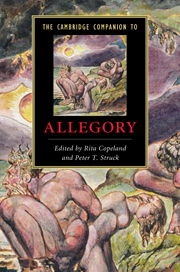Book contents
- Frontmatter
- Introduction
- Part I: Ancient foundations
- Part II: Philosophy, theology, and poetry 200 to 1200
- Part III: Literary allegory: philosophy and figuration
- Part IV: The fall and rise of allegory
- 15 Romanticism’s errant allegory
- 16 American allegory to 1900
- 17 Walter Benjamin’s concept of allegory
- 18 Hermeneutics, deconstruction, allegory
- 19 Allegory happens: allegory and the arts post-1960
- Further reading
- Index
17 - Walter Benjamin’s concept of allegory
from Part IV: - The fall and rise of allegory
Published online by Cambridge University Press: 28 January 2011
- Frontmatter
- Introduction
- Part I: Ancient foundations
- Part II: Philosophy, theology, and poetry 200 to 1200
- Part III: Literary allegory: philosophy and figuration
- Part IV: The fall and rise of allegory
- 15 Romanticism’s errant allegory
- 16 American allegory to 1900
- 17 Walter Benjamin’s concept of allegory
- 18 Hermeneutics, deconstruction, allegory
- 19 Allegory happens: allegory and the arts post-1960
- Further reading
- Index
Summary
The work of Walter Benjamin has made a fundamental contribution to the re-assessment of allegory during the twentieth century. It not only made a powerful case for the significance of allegory as a radical art practice but also extended its reach from the aesthetic to other realms of experience. However, the precise contours of the concept of allegory are hard to trace because Benjamin lends such broad significance to the allegorical. In so far as he possessed an integrated theory of allegory, it is one made up of the intersection of several discrete lines of inquiry whose precise relations were left deliberately undefined. For Benjamin, allegory is a concept with implications that are at once philosophical, religious, aesthetic, political and historical. In many ways it is emblematic of the internal complexity of Benjamin's work, which is rooted in the attempt to bring together the approaches of philosophy, aesthetics and cultural history. While the manifold senses of allegory are never bound unequivocally together into a general theory, it is clear that they depend upon each other, often in quite astonishing and illuminating ways. It is also evident that allegory is central not only to his understanding of modernism in art and literature, but also to the shifts of religious and political experience that for Benjamin constituted modernity.
- Type
- Chapter
- Information
- The Cambridge Companion to Allegory , pp. 241 - 253Publisher: Cambridge University PressPrint publication year: 2010
- 6
- Cited by

